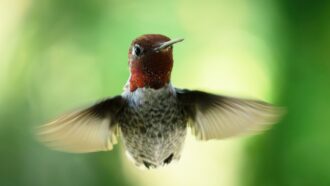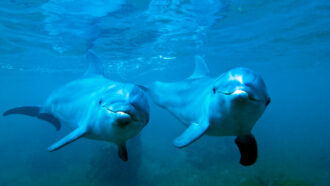Wild Things
Science told through comics
-
 Animals
AnimalsSome fish have legs that can taste prey underfoot
Taste buds on those legs may explain why northern sea robins are so good at finding food that is buried in the sandy seafloor.
-
 Animals
AnimalsTiger beetles weaponize sound to ward off bat predators
Some beetles make ultrasonic clicks that camouflage them as toxic tiger moths, warning hungry bats to stay away.
By Maria Temming and JoAnna Wendel -
 Animals
AnimalsChimps and bonobos recognize familiar faces even after decades apart
Chimpanzees and bonobos may boast the longest social memory of any animal besides humans.
By Maria Temming and JoAnna Wendel -
 Animals
AnimalsSee how hummingbirds sneak through small spaces
Anna’s hummingbirds can use a couple of different techniques to get through gaps smaller than their wingspan.
-
 Animals
AnimalsHere’s why thousands of octopuses gather at the ‘Octopus Garden’
Underwater cameras and other instruments investigated why so many pearl octopuses gather here to mate and nest.
By Maria Temming and JoAnna Wendel -
 Animals
AnimalsToothed whales use their noses to whistle and click
Much as people do, toothed whales, such as dolphins and sperm whales, make noises in three different vocal registers.
By Maria Temming and JoAnna Wendel -
 Animals
AnimalsRats can bop their heads to a musical beat
Rats’ rhythmic response to human music doesn’t mean they like to dance. But it may shed light on how brains evolved to perceive rhythm.
-

These lemurs take nose-picking to a new level
A nose-picking aye-aye’s spindly middle digit probably pokes all the way into the back of the throat, CT scans show.
By Maria Temming and JoAnna Wendel -
 Animals
AnimalsHow boa constrictors squeeze their prey without strangling themselves
Tracking boas’ ribs in X-ray videos revealed the snakes’ squeezing secrets. It’s the latest Wild Things cartoon from Science News Explores.
By Maria Temming and JoAnna Wendel -
 Animals
AnimalsGoldfish driving ‘cars’ offer new insight into navigation
Fishes’ internal sense of direction is not limited to their natural environment. The latest Wild Things cartoon from Science News for Students.
By Maria Temming and JoAnna Wendel -
 Animals
AnimalsA panda stands out at the zoo but blends in the wild
A panda may stand out among bamboo at the zoo, but in the wild, its black-and-white coloring camouflages it from predators. Learn more with this web comic.
By Sarah Zielinski and JoAnna Wendel -
 Animals
AnimalsCockatoos learn from each other how to open garbage bins
The bin-opening behavior is an example of social learning. It’s also the basis of a foraging culture. Learn more in this web comic.
By Sarah Zielinski and JoAnna Wendel